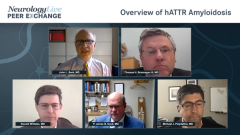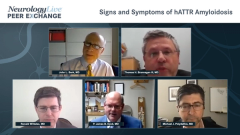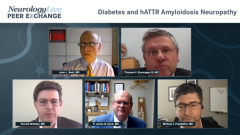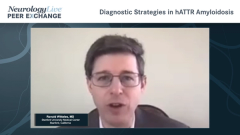
Evaluating hATTR Amyloidosis Therapy
Clinicians elaborate on key trial data revealed through the APOLLO and NEURO-TTR studies in hereditary ATTR amyloidosis.
Episodes in this series

John L. Berk, MD: Dr Dyck, help us here. Dr Polydefkis said there was a 28-point worsening of neuropathy in the placebo group of the APOLLO study and a 6-point actual improvement of scores from beginning to end of study in the treated group. What does that mean? How do we interpret the complex and comprehensive scoring system?
P. James B. Dyck, MD: The Neuropathy Impairment Score [NIS] troubles people because they don’t know what it means. Simply, it is a measurement of patients’ deficits on a neurological examination. It’s weakness, it’s reflex changes, and it’s sensory loss, and it’s adding those together into a score. An NIS score of 50 is a moderate neuropathy; 100 is a severe neuropathy. A worsening of 28 points is a big deal. That was part of the point I was making earlier: The reason these studies were able to be effective is that patients with this disease worsen fairly dramatically over time.
John L. Berk, MD: Can you give us an idea of what the difference would functionally be if I’m in the study and I worsen by 28 points?
P. James B. Dyck, MD: That might mean that you went from walking independently to not walking; it is a big difference. Improvement of 6 points is a real improvement. People always want to make head-to-head comparisons between these 2 studies. I always try to avoid doing that. The reason is 1 study went for 18 months; the other went for 15 months. They also used slightly different end points, and they allowed slightly different degrees of severity in neuropathy of the patients who went in there. It is a mistake to say that 1 drug is better than the other because there are these differences in the studies.
The thing that is very clear about both studies is that they’re both home runs. Both drugs work incredibly well. Both not only stop progression of neuropathy but had sizable numbers of patients in the study actually having improvement. To me, the big difference really has to do with the adverse-effect profile. One advantage of inotersen is that it’s a subcutaneous drug; patisiran is an intravenous drug. Inotersen had the thrombocytopenia, so that was a real potential problem. Since they have begun a surveillance program, they really stopped that problem with the thrombocytopenia. From my perspective, it really comes down to patients’ convenience about which of these drugs is better. If a subcutaneous drug is better for you, you might want to go with inotersen. If you’re not bothered by the intravenous route, you have less monitoring and fewer potential adverse effects with patisiran.
John L. Berk, MD: Dr Polydefkis, how do you decide between these 2 agents when prescribing TTR [transthyretin] gene silencer?
Michael J. Polydefkis, MD: It is a discussion with the patient. We talk about many of the things Jim just touched upon: the route of administration, subcutaneously vs intravenously; the frequency, weekly versus every 3 weeks; and the need for monitoring. That discussion leads to a mutual decision.
John L. Berk, MD: On the West Coast, Dr Witteles, even though you’re a cardiologist, you’re an honorary neurologist because you’re codirector. How do you guys differentiate between these 2 agents? Or do you simply leave it up to the patient?
Ronald Witteles, MD: I’d follow somewhere in between that vs paftisiran clearly being superior. I agree that they were different trials. Unless you have head-to-head in a given trial, there’s never going to be a perfect comparison. We have the data that we have. You can even extend it to some of the substudies like the cardiac side. In APOLLO you did see some clear improvement from a cardiac side, which was not so clear in the inotersen study. When you look at it all, if you had to bet if 1 of them was a bit more efficacious than the other, the answer would be yes; it seems like patisiran was a bit more efficacious. Is that as good as a head-to-head study? Of course not, but those are the data we have.
Then you do have those safety issues: the thrombocytopenia, glomerulonephritis, and a little imbalance that wasn’t statistically significant but that was still notable on deaths. I put all those together. Though I discuss both options with patients, I generally recommend patisiran for them unless the IV [intravenous] infusion or the premeds are going to be a specific problem. For the big picture, I agree entirely with Dr Dyck. The big takeaway is not which is better. It’s that, my lord, these were both grand slams, not just home runs. They were both incredible, and the biggest thing is to get somebody on 1 of these 2 agents as soon as you can when you make the diagnosis.
John L. Berk, MD: Dr Brannagan, do you use any TTR protein stabilizers for your patients with neuropathy? Dr Witteles is saying that’s a waste of time.
P. James B. Dyck, MD: I’m not sure he said that.
Ronald Witteles, MD: Hold on, I didn’t say that. No, I don’t believe that at all.
Thomas H. Brannagan III, MD: I do certainly have patients who are on these medications, and I work closely with our cardiologists. There are some data that have shown a survival benefit with stabilizing drugs. I have to say, I’m not entirely certain that combining a silencer and a stabilizer is necessarily more beneficial. However, there are not survival data with the RNA silencers, and there are, including your own work, with the stabilizing drugs. I certainly have people who are combined. We also sometimes use the stabilizers, particularly diflunisal, when people don’t have neuropathy and don’t have cardiomyopathy but do have carpal tunnel, which is from amyloid, as a preventive medication. We usually discuss with them that there are no clear-cut data, but that it’s potentially a treatment. Studies on this area need to be done, but at this moment when we don’t have studies, we sometimes do that.
P. James B. Dyck, MD: I want to interrupt here because I know Dr Berk is not going to toot his own horn. I’m going to toot his horn. He did a very nice study with my father on the use of diflunisal in hATTR [hereditary transthyretin-mediated amyloidosis]. He showed, very convincingly, with the modified Neuropathy Impairment Score + 7 that diflunisal slows the progression of hATTR polyneuropathy. It’s a very important study, and I do think the role of membrane stabilizers should still be considered. Some sort of cocktail may be the ultimate answer, but we don’t have that data. We should not abandon diflunisal or tafamidis.
Ronald Witteles, MD: I agree with that entirely. In fact, we try to get most of the patients on a stabilizer who are on patisiran or inotersen as well if they have clear cardiac involvement, as long as they can have it paid for and it’s not huge out-of-pocket expense. I do tend to try to get them on both a stabilizer and a silencer, so tafamidis plus most of the time patisiran or inotersen. In the absence of being able to do so, unless they have a contraindication, I do usually put them on diflunisal. As was said, do we know that diflunisal plus a silencer is better than a silencer alone? No. For people who have real phenotypic neurological involvement and cardiac involvement, if it’s 1 of 2 I can choose, I will definitely go the silencer route because we know that the difference in the progression of their neuropathy is so much dramatically better with a silencer vs the stabilizers.
John L. Berk, MD: Thank you for watching this NeurologyLive® Peer Exchange. If you enjoyed the content, please subscribe to our e-newsletters to receive upcoming Peer Exchanges and other great content right in your in-box.
Transcript Edited for Clarity
Newsletter
Keep your finger on the pulse of neurology—subscribe to NeurologyLive for expert interviews, new data, and breakthrough treatment updates.













